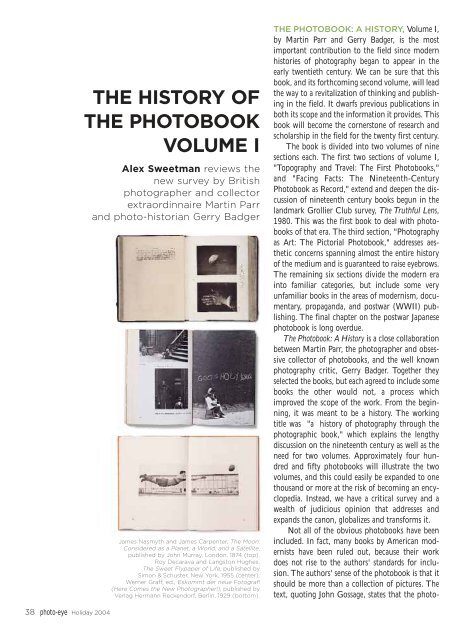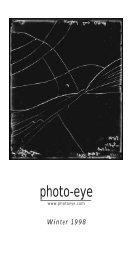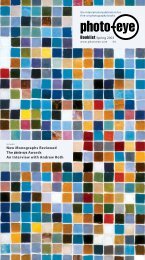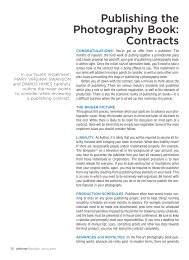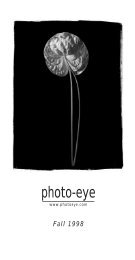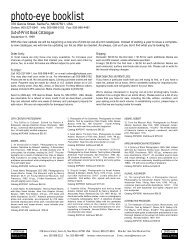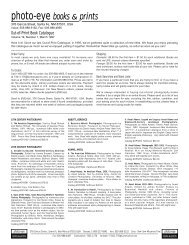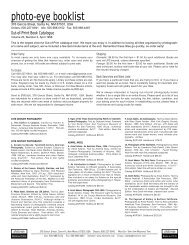THE HISTORY OF THE PHOTOBOOK VOLUME I - Photo Eye
THE HISTORY OF THE PHOTOBOOK VOLUME I - Photo Eye
THE HISTORY OF THE PHOTOBOOK VOLUME I - Photo Eye
Create successful ePaper yourself
Turn your PDF publications into a flip-book with our unique Google optimized e-Paper software.
<strong>THE</strong> <strong>HISTORY</strong> <strong>OF</strong><br />
<strong>THE</strong> <strong>PHOTOBOOK</strong><br />
<strong>VOLUME</strong> I<br />
Alex Sweetman reviews the<br />
new survey by British<br />
photographer and collector<br />
extraordinnaire Martin Parr<br />
and photo-historian Gerry Badger<br />
James Nasmyth and James Carpenter, The Moon:<br />
Considered as a Planet, a World, and a Satellite,<br />
published by John Murray, London, 1874 (top).<br />
Roy Decarava and Langston Hughes,<br />
The Sweet Flypaper of Life, published by<br />
Simon & Schuster, New York, 1955 (center),<br />
Werner Graff, ed., Eskommt der neue Fotograf!<br />
(Here Comes the New <strong>Photo</strong>grapher!), published by<br />
Verlag Hermann Reckendorf, Berlin, 1929 (bottom).<br />
<strong>THE</strong> <strong>PHOTOBOOK</strong>: A <strong>HISTORY</strong>, Volume I,<br />
by Martin Parr and Gerry Badger, is the most<br />
important contribution to the field since modern<br />
histories of photography began to appear in the<br />
early twentieth century. We can be sure that this<br />
book, and its forthcoming second volume, will lead<br />
the way to a revitalization of thinking and publishing<br />
in the field. It dwarfs previous publications in<br />
both its scope and the information it provides. This<br />
book will become the cornerstone of research and<br />
scholarship in the field for the twenty first century.<br />
The book is divided into two volumes of nine<br />
sections each. The first two sections of volume I,<br />
"Topography and Travel: The First <strong>Photo</strong>books,"<br />
and "Facing Facts: The Nineteenth-Century<br />
<strong>Photo</strong>book as Record," extend and deepen the discussion<br />
of nineteenth century books begun in the<br />
landmark Grollier Club survey, The Truthful Lens,<br />
1980. This was the first book to deal with photobooks<br />
of that era. The third section, "<strong>Photo</strong>graphy<br />
as Art: The Pictorial <strong>Photo</strong>book," addresses aesthetic<br />
concerns spanning almost the entire history<br />
of the medium and is guaranteed to raise eyebrows.<br />
The remaining six sections divide the modern era<br />
into familiar categories, but include some very<br />
unfamiliar books in the areas of modernism, documentary,<br />
propaganda, and postwar (WWII) publishing.<br />
The final chapter on the postwar Japanese<br />
photobook is long overdue.<br />
The <strong>Photo</strong>book: A History is a close collaboration<br />
between Martin Parr, the photographer and obsessive<br />
collector of photobooks, and the well known<br />
photography critic, Gerry Badger. Together they<br />
selected the books, but each agreed to include some<br />
books the other would not, a process which<br />
improved the scope of the work. From the beginning,<br />
it was meant to be a history. The working<br />
title was "a history of photography through the<br />
photographic book," which explains the lengthy<br />
discussion on the nineteenth century as well as the<br />
need for two volumes. Approximately four hundred<br />
and fifty photobooks will illustrate the two<br />
volumes, and this could easily be expanded to one<br />
thousand or more at the risk of becoming an encyclopedia.<br />
Instead, we have a critical survey and a<br />
wealth of judicious opinion that addresses and<br />
expands the canon, globalizes and transforms it.<br />
Not all of the obvious photobooks have been<br />
included. In fact, many books by American modernists<br />
have been ruled out, because their work<br />
does not rise to the authors' standards for inclusion.<br />
The authors' sense of the photobook is that it<br />
should be more than a collection of pictures. The<br />
text, quoting John Gossage, states that the photo-<br />
38 photo-eye Holiday 2004
ook should be a great collection of pictures<br />
and "it should make that work function as a<br />
concise world within the book itself. And finally,<br />
it should deal with content that sustains an<br />
ongoing interest." In the opinion of the<br />
authors, Stieglitz, Weston, Adams, and others,<br />
do not rise to this level. These omissions are offset<br />
by the vast, international scope of the project,<br />
which brings many new titles to light for<br />
the first time. This alone is worth the price of<br />
admission.<br />
Parr's inspiration for the project was Frank's,<br />
The Americans. For Badger, it was Evan's<br />
American <strong>Photo</strong>graphs. These two books are<br />
tough, critically engaged projects which elevated<br />
the role of the author in the work. The standard<br />
is high and the achievement is impressive.<br />
The <strong>Photo</strong>book: a History is divided into overarching<br />
periods in world culture which reveal<br />
the zeitgeist, what Badger refers to as the<br />
"subject" and "period tendency." The various responses<br />
of the photographers to their lives and<br />
times both reflect and create a distinct period<br />
style described and, more importantly, illustrated<br />
in the different chapters.<br />
The illustrations themselves are a feast.<br />
However, this feast points up a much larger and<br />
very troubling famine. And that is the utter<br />
failure of our major cultural institutions to<br />
adequately address the phenomenon, and to<br />
collect these works and make them available.<br />
<strong>Photo</strong>graphic education currently addresses<br />
only a handful of books. The same failure is<br />
reflected in our national library system, which<br />
does not systematically collect contemporary<br />
photography books. One can only hope that<br />
many individuals will form significant personal<br />
collections of photobooks and leave them to<br />
their preferred institutions for the sake of posterity.<br />
Unlike many histories which keep a safe distance<br />
from the turmoil of the present until it<br />
can be sorted out by consensus formed over<br />
time, this one is fully engaged with the present<br />
and will conclude with a critical view of contemporary<br />
photobook publishing, as well as a<br />
final epilogue: "The Ultimate <strong>Photo</strong>book."<br />
The broad scope of this ambitious project will<br />
do much to stimulate our ongoing discussions<br />
of the photobook, past, present, and future.<br />
And there will be much to quibble about; much<br />
fact-checking, disputation, and many PhD dissertations.<br />
A word to the wise, if photobooks are important,<br />
then this history of the photobook is very<br />
important.<br />
The <strong>Photo</strong>book: A History. Volume 1. By<br />
Martin Parr and Gerry Badger. 320 pp., 850<br />
color and black-and-white illustrations, 10 x<br />
11½. Cat# PI146H $75.00 Published by<br />
Phaidon, London.<br />
800 227 6941 photo-eye 39


